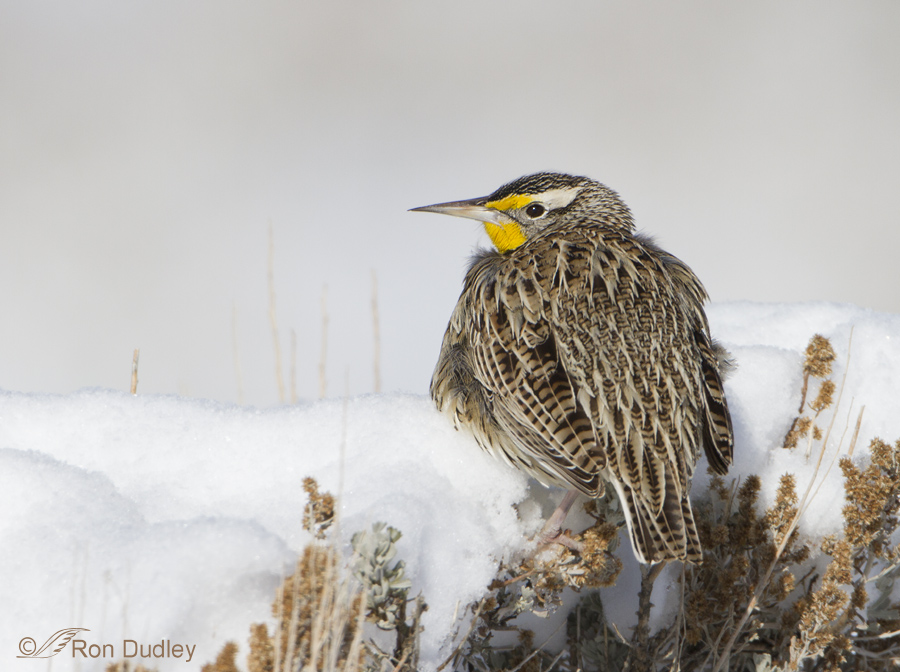In northern Utah, anticipating how long our Western Meadowlarks will stick around during winter is always a guessing game.
Migration patterns of this species are complex and difficult to predict. Some birds simply migrate from higher elevations during winter. Many migrate south from mid October through November but some of them will overwinter here during mild years. Interestingly, when they do migrate, research indicates that they use the azimuth (elevation) of the sun, corrected for time of day, to select compass direction for migration. They become confused and disoriented on cloudy days.
 1/2000, f/8, ISO 500, Canon 7D, 500 f/4, 1.4 tc, not baited, set up or called in
1/2000, f/8, ISO 500, Canon 7D, 500 f/4, 1.4 tc, not baited, set up or called in
I found this bird almost exactly a year ago (12/28/12) as it perched on a mix of rabbitbrush and sage that was covered with a thick layer of fresh snow on Antelope Island. This was the last meadowlark I photographed until the middle of the following March. Given how brutal our weather was late last winter (January and February particularly) I hope this bird headed south very soon after this photo was taken.
I’ve seen very few meadowlarks on the island (or any other songbirds for that matter) for weeks now so I suspect our early very cold temperatures prompted even the stragglers to move south a little early. I doubt if we’ll have many meadowlarks (that survive) overwintering this year.
Ron


Top five favorite bird! I saw several outside of Goshen last week and happily thought ahead to their springtime song.
That setting really suits it, despite the poor bird looking cold. They’re a bird I hope to see soon – providing the cold hasn’t got to them!
Bird navigational techniques are so fascinating, aren’t they? I don’t know anything about meadowlarks but am surprised if they become disoriented on cloudy days when they can’t directly see the sun. I believe most birds (and other animals like bees) who steer by the sun can do just as well at inferring the location of the sun on cloudy days by perceiving the planes of polarized light. They can typically see that light whereas we need optical equipment to help us. As you surely know better than I, the bands of polarized light are especially visible around dawn and dusk… so some recalibrate their compasses twice a day at those times.
Do meadowlarks lack the ability to see polarized light? If so, do you know why? And do you happen to know if they can “see” earth’s magnetic fields via the rate of decay of free radicals in their eyes? For me, that’s the most remarkable component of birds’ special navigational sensorium. I, too, hope all these delicate little ones have found safe harbor somewhere! In haste tonight…
A gorgeous songster. I can remember you giving us a link to their songs, and my heart sang with them. I too hope that they have gone to warmer climes and return to delight you/us next year.
That poor bird looks cold and uncomfortable…I’ve seen the western meadowlarks, but haven’t–or heard–an eastern one in many, many years. One of my Lakota friends says he can understand what they are singing. I hope that one is still around. our son and his family live in Buffalo, where they are expecting 4-6′ of snow…I wonder (and worry) how human and wildlife will do…
One of my favorite birds and of course I never see them here on the East coast…Great photo, Thanks!
Bill, I expect you often see the eastern variety. I learned today that after Audubon’s report in 1844 of a meadowlark west of the Mississippi with a different song than the bird in the east it took them a century to figure out the status of the eastern and western (two species or not?). Thank you.
I love the song of these birds. I found a lot of them by following their sweet song in N California in Jan last year.Hopefully you will see them again. Thanks for sharing.
I know what you mean about their song, Rima. The hills of Antelope Island fairly ring with that sweet song in spring and early summer. Sometimes I stop my pickup along the road just to get out and listen to them. It brings back fond memories of my childhood in Montana.